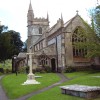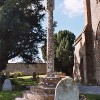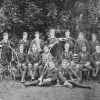On an autumn afternoon the parish of Trent is a picture of tranquillity and belies the fact that it has been a refuge for a Catholic King of England and a retirement home for an Archbishop of Canterbury and judging by the bullet holes in the church weather vane it has also seen turbulent times as well.
These days the parish is on the Dorset side of the Dorset/Somerset divide being about equal distance from the Somerset town of Yeovil and Sherborne in Dorset. Trent is a quiet rural parish and besides farming and some fine houses is home to little more than a pub, the Rose and Crown, and the parish church which is dedicated to St. Andrew.
For a few days in September of 1651, unknown to most residents of the village, the Catholic King Charles II was hiding in the Manor House just one hundred yards from the church. Some of the more fanatical Protestant dissenters had their suspicions about who the mysterious guest of the Wyndham family was and were secretly planning to raid the house but then events took an ironic twist: a soldier arrived in the village claiming to have personally killed the King. The Protestants celebrated the news by ringing the church bells and making a bonfire, their plans to raid the Manor House quickly forgotten. Rather than killing the King the soldier probably saved his life!
Walking through the tidy and well kept-up churchyard you pass-by a tall memorial; the lower part has stood here since the 15th century but it was damaged during the Civil War and was only restored in the 20th century as a memorial to the dead of World War I.
Continue on past the south porch entrance to the church to the western edge of the churchyard and you will find, unusually in my experience of visiting churches, a small building housing a public lavatory and washroom kept to a high standard.
Entrance to the church is through the south porch where a notice hangs: “All Persons are requested to take off, Pattens and Cloggs before entering the Church.” Looking to the west end of the nave there is a door of 15th century origin which leads into the modern vestry. The window above the doorway is of the 15th century and of three lights as are the two windows in the north wall of the nave, though they have been much restored. The two windows in the south wall are modern. The roof of the nave is 19th century.
The pews are worth more than a passing mention. Obviously pre-Reformation and probably carved in the early 16th century, some show floral designs, others figures of people, beasts, birds and lettering. It is said these along with other images, crucifixes and candlesticks were removed and hidden from a troop of Parliamentary soldiers sent to Trent in 1643 on the orders of the Puritan Committee to demolish “all Monuments of Superstition and Idolatry.” This is when the upper part of the churchyard memorial mentioned earlier was destroyed.
Looking east towards the choir and chancel we see first the screen which is said to have come from Glastonbury Abbey. It dates from the 15th century. Behind the screen the choir and chancel and a large east window of four lights with similar windows but of only three lights in the north and south walls.
You are asked not to enter the north or Manor chapel but there are steps you can mount to see in. The chapel houses three effigies; the oldest probably being of Sir Roger Wyke who married a lady of Trent. Sir Roger died about 1380 and is represented as a knight in armour. The second is probably of John Franks. He was a sergeant-at-law and a local man who became Master of the Rolls and for a short time acted as Lord Chancellor to King Henry VI: he died about 1438. The 19th century effigy is of the Revd. William Turner, Rector of Trent from 1835 to 1875; it was his wife who founded the almshouses. Apparently the effigy was carved in 1853 and kept in the rectory coach house until his death in 1875. Mr Turner and his wife are both buried in the churchyard though a vault was prepared for them.
There is a small table surrounded by several chairs and the chapel is lit by three modern windows in the north wall and a restored early 14th century three light window in the east wall which depicts the military saints; St. George; St. Martin and St. Michael. The window remembers General Lord Rawlinson who died in 1925. As you peer into the Manor chapel you will notice the arch of 13th or early 14th century origin. The mirror writing on the arch reads: “All flesh is grass and the glory of it is as the floure of the feilde” (Isaiah Chapter 40, verse 6 and Psalm 103, verse 15.) The mirror writing was supposed to remind the ladies of the manor (this is where they sat) of their religious duties if they looked at a mirror during the service.
The south transept area is now largely a memorial to Lord Fisher of Lambeth, Archbishop of Canterbury from 1945 to 1961. His contributions to the religious and social life of the nation are many but he will be mostly remembered for the Coronation of Queen Elizabeth II in Westminster Abbey on the 22nd of June 1953. Earlier, in 1947, he had married the then Princess Elizabeth to Prince Phillip, Duke of Edinburgh. On his retirement he came to Trent where it is said he achieved his ambition to become the assistant parish priest. He attracted large congregations when he preached here and in the neighbouring Comptons. He died peacefully in the village on the 15th of September 1972 and his funeral was held in the church on the 20th of September. Afterwards his coffin was lowered into the vault under the 15th century churchyard memorial. The vault originally intended for the former rector William Turner.
It was the Archbishop’s suggestion that the south transept became the baptistry. The font is probably Victorian, though the elaborately carved cover is of the 15th century. On display here is one of the Archbishop’s copes.
The south transept is the ground floor of the tower and spire. St. Andrews, is one of three Dorset churches with a medieval spire – the others being Iwerne Minster and Winterbourne Steepleton. The second storey has in each of the East, South and West walls, a window of two lights.
The bell-chamber has, in each wall, a window similar to those just described but larger and houses six bells and five of them would have been rung to celebrate the supposed death of King Charles II in 1651. Nine years later Charles was restored to the throne and the Wyndham family forbade the Trent bell-ringers to ring a peal to celebrate this event; instead ringers from Compton were invited to ring the Trent bells. It has since been the tradition for the Compton bell-ringers to ring the Trent bells each year on Oak Apple Day, the 29th of May, the anniversary of the Restoration of Charles II.
St. Andrews is built from local rubble with ashlar dressings of Ham Hill stone. The roofs are covered with stone slates. The north chapel and the nave date from the 13th century, the south tower and porch were added in the 14th century and the chancel was rebuilt in the 15th century.



